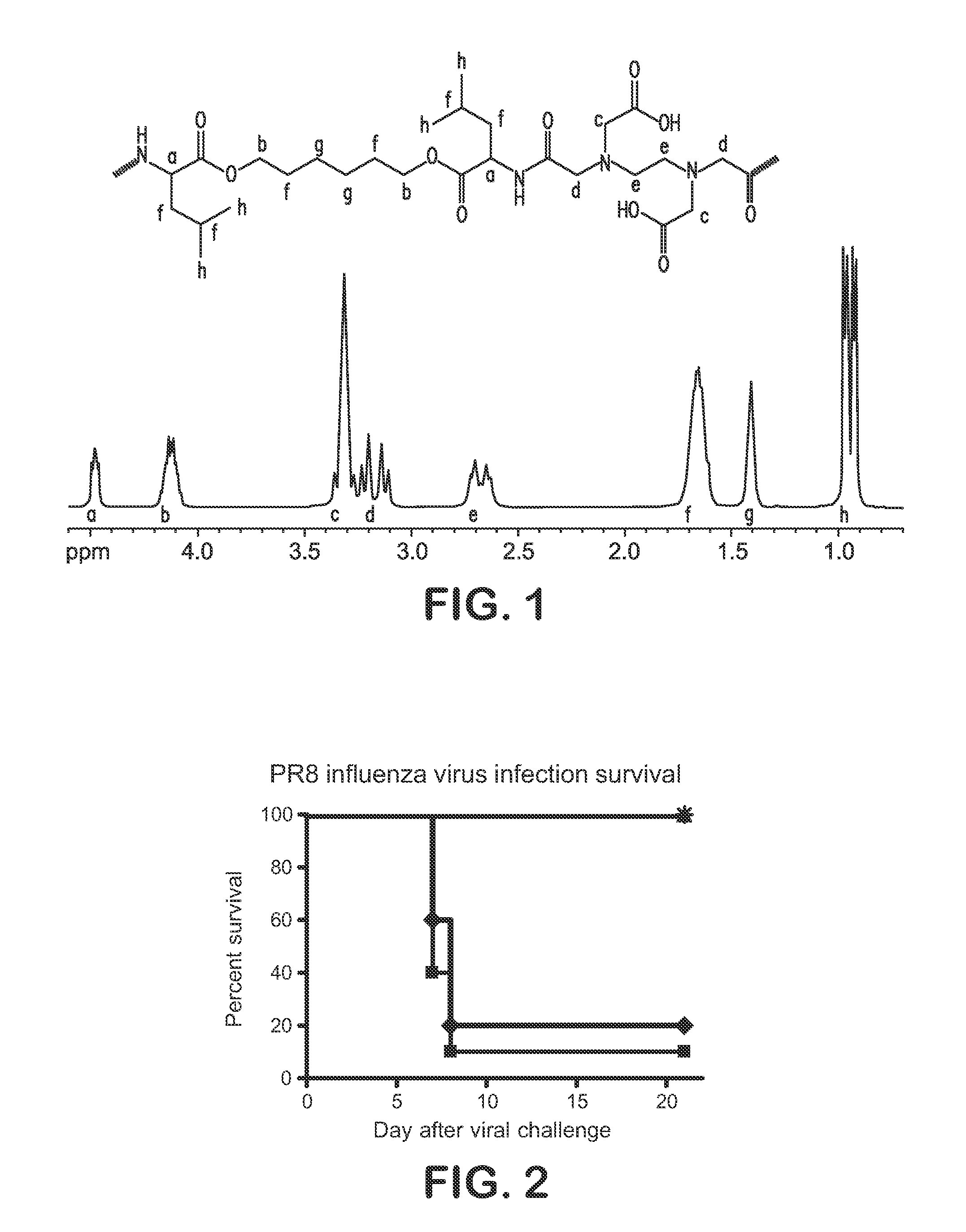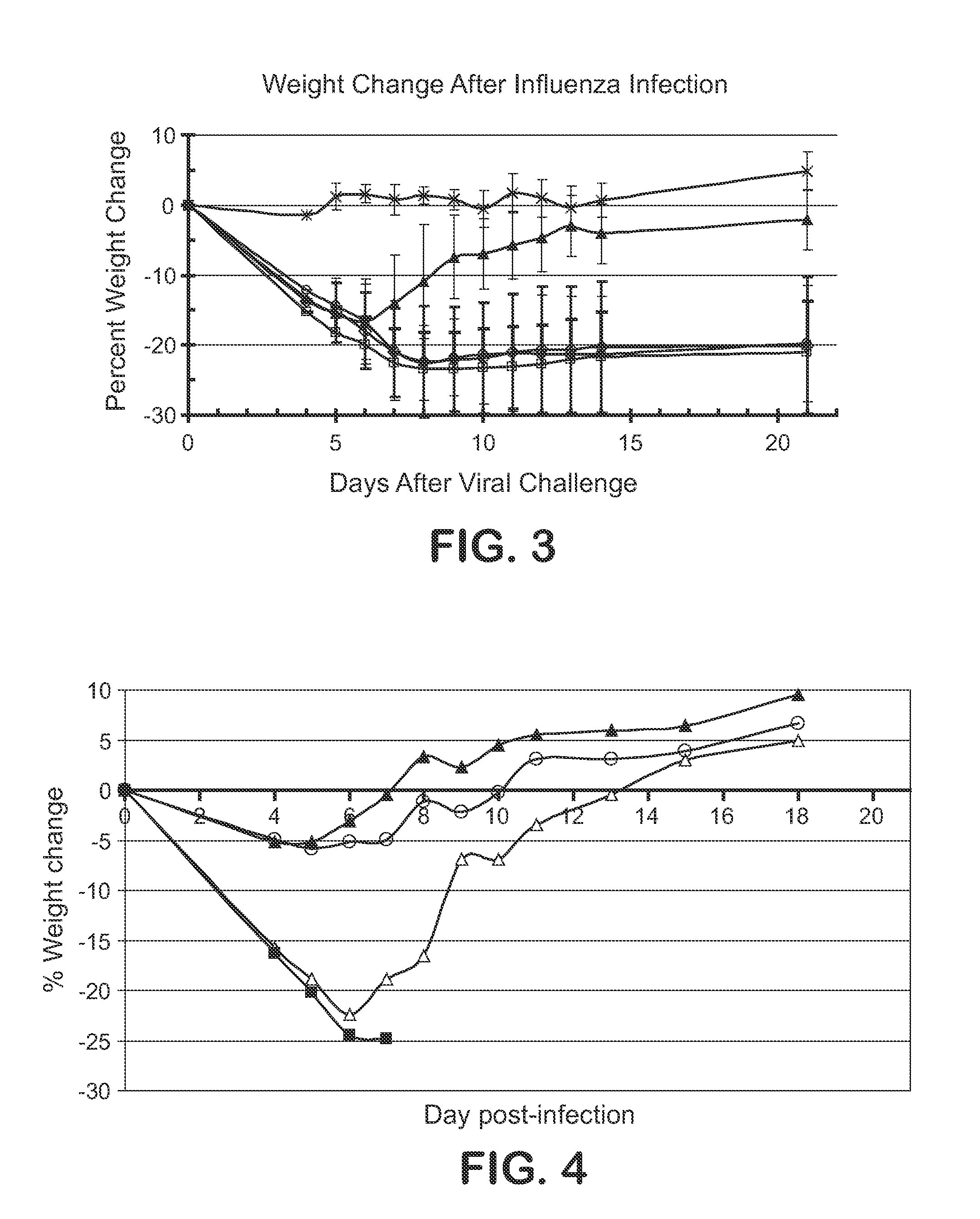Biodegradable metal-chelating polymers and vaccines
a metal-chelating polymer, biodegradable technology, applied in the direction of powder delivery, pharmaceutical non-active ingredients, pharmaceutical delivery mechanism, etc., can solve the problems of limited clinical application of such macromolecular systems, including those prepared from typical biodegradable polymers, such as dextrans, polylysine,
- Summary
- Abstract
- Description
- Claims
- Application Information
AI Technical Summary
Problems solved by technology
Method used
Image
Examples
example 1
[0102]Materials Reagents: Diethylenetriamine pentaacetic dianhydride (DTPA-DA, 98%), ethylenediamine tetraacetic dianhydride (EDTA-DA, 98%), Ethylene glycol-bis(2-aminoethylether)-N,N,N′,N′-tetraacetic acid (EGTA, IDRANAL™ IV), all from Sigma-Aldrich were used as received. Other dianhydrides, for example EGTA dianhydride, can be prepared by acetic anhydride dehydration of the parent tetraacid in pyridine as reported by Geigy, J. R. A.-G. in Fr. Patent 1,548,888 (C1.C07d); Chem. Abstr. (1969) 71:81380q.
[0103]Iminodisuccinic acid (IDS) disodium salt (Baypure CX100 G, 77%) was a gift sample from Obermeier GmbH & Co, Bad Berleburg, Germany. Amino acids: L-leucine, L-phenylalanine, glycine, L-arginine, L-lycine and diols 1,3-propanediol and 1,6-hexanediol were obtained from Sigma-Aldrich.
[0104]Anhydrous solvents Dimethylformamide (EMD Chemicals, Inc, NJ), N,N-dimethyl formamide (DMF), dimethylsulfoxide (DMSO), N,N-dimethylacetamide (DMAc), (Fisher Scientific) and other solvents Acetone, ...
example 2
EGTA Based PEA Synthesis [CO-EGTA]: One-Pot Reaction (Scheme 1)
[0139]
[0140]30 mL dry dichloromethane (DCM) and 5 g (13.1 mmol) of ethylene glycol-bis(2-aminoethylether)-N,N,N′,N′-tetraacetic acid (EGTA) were charged into a 250 mL three neck round bottom flask, cooled down on ice bath and blanketed under argon. Then, 4.55 mL (33 mmol) of trifluoroacetic anhydride was added and stirred until the white solid was completely converted into a transparent, pale yellow, EGTA dianhydride viscous layer (ca. 4 hours). Ice bath then was replaced with methanol / dry ice bath and reaction mixture was cooled down to −40° C. to −30° C. Separately, 16.5 mL (0.118 mol) of triethylamine (TEA) was diluted in 20 mL of dry DMF and added drop-wise into reaction mixture over a 1 hr period and stirring was continued for 30 minutes at about −30° C. Then, 9.048 g (13.1 mmol) of diamine monomer di-p-toluenesulfonic acid salt of bis-(L-leucine)-1,6-hexanediol diester was added and stirred overnight at room temper...
example 3
Formulation of PEA.EDTA.Leu(6).Nickel [Paclitaxel] Nanoparticles
[0141]This experiment was conducted to illustrate the invention procedure for formulation of invention metal-chelating polymers as nanoparticles for delivery of a non-water soluble bioactive agent, Paclitaxel.
[0142]Preparation of aqueous polymer stock solution (A): 120 mg amount of invention polymer PEA.EDTA.Leu(6) (Mw=24 kg / mol, Mw / Mn=1.68, of Formula I, where R1=—CH2—N(CH2CO2H)(CH2)2N(CH2CO2H)—CH2—; R3═CH2CH(CH3)2, R4═(CH2)6) was dissolved in 3 mL of 1-Methyl-2-pyrrolidinone (NMP) at room temperature and added drop wise at a rate of 1 mL / min into 17 mL of aqueous 25 mM N-(2-Hydroxyethyl)piperazine-N′-(2-ethanesulfonic acid) (HEPES) buffer with pH=7.0. The buffer solution was stirred vigorously at room temperature to afford a homogenous polymer solution with 6 mg / mL concentration. Stirring was continued for 15 minutes and then the solution was dialyzed over night against 2 L of 25 mM HEPES buffer containing 150 mM NaCl...
PUM
| Property | Measurement | Unit |
|---|---|---|
| Temperature | aaaaa | aaaaa |
| Temperature | aaaaa | aaaaa |
| Temperature | aaaaa | aaaaa |
Abstract
Description
Claims
Application Information
 Login to View More
Login to View More - R&D
- Intellectual Property
- Life Sciences
- Materials
- Tech Scout
- Unparalleled Data Quality
- Higher Quality Content
- 60% Fewer Hallucinations
Browse by: Latest US Patents, China's latest patents, Technical Efficacy Thesaurus, Application Domain, Technology Topic, Popular Technical Reports.
© 2025 PatSnap. All rights reserved.Legal|Privacy policy|Modern Slavery Act Transparency Statement|Sitemap|About US| Contact US: help@patsnap.com



